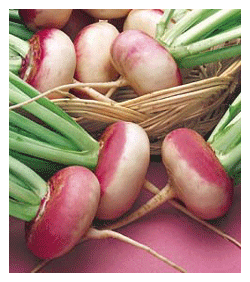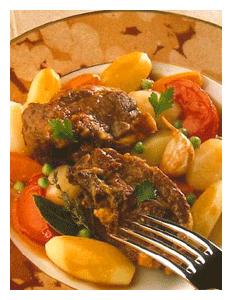Lamb Stew with Spring Vegetables: Navarin d’agneau printanier
4118

This week’s “French Cooking without a Fuss” features a traditional dish called Navarin d’agneau printanier (Lamb Stew with Spring Vegetables). The focus of this dish is its use of new légumes, which includes baby carrots, spring onions, new potatoes, peas and turnips.
Turnips are a harbinger of spring in France. The French appreciate navets during this season for their delicious sweet flavor. They are one of the oldest cultivated foods and are believed to have originated with the ancient Greeks. Turnip fossils dating back thousands of years have been found in caves in western China. There’s even evidence of prehistoric man eating raw turnips and then later roasting them. Ancient caves in France are decorated with paintings showing turnips being boiled in clay pots.
Turnips grew wild in Northern Africa and were spread northward throughout Europe by the Romans. Called the “potato of ancient cuisines,” turnips became the food of Europe’s poor. It is said that the nobles were forbidden to eat them because they were only good enough for the lower classes. Later, the nobility changed their minds and loved to eat them in many different ways—braised, glazed, fried, etc, and smothered in honey. Turnips were first sown in the New World (Canada) by the French explorer Jacques Légume. They were taken to the American colony of Virginia in 1609.
Navets are root vegetables related to radishes and mustards. The ones you find in the grocery store or the marché will range from golf-ball size to baseball size. In France there are about 30 varieties, but only several are widespread. The navets primeurs (spring turnips) are harvested from February to June. The two most popular are the navet de Milan rose and the navet de Milan rouge. The most common varieties have creamy white skin with shades of purple or reddish pink at the top; some are completely white. Newly harvested turnips are sometimes sold with their leaves, which can be cooked and eaten—like southern turnip greens. They’re available all year round, but their peak season is between May and October.
Select firm turnips that are smooth and not shriveled. I prefer the smaller ones, as they are usually sweeter than the large ones, which tend to be fibrous and a bit bitter. To store them, just cut off the greens and place in plastic bags in the crisper section of the refrigerator; use within 2 weeks. They are high in vitamin C; a good source of iron, fiber, calcium and vitamin E; and are low in calories (1 cup of boiled turnips is only 33 calories). They can be boiled, broiled, braised, steamed and baked. Raw turnip sticks are a very healthy snack. In French cuisine turnips play an important part in certain recipes such as the winter dish of pot-au-feu (see my recipe on Bonjour Paris) and the spring dish of Navarin d’agneau. Here’s the delicious recipe for this spring lamb stew:
Navarin d’agneau printanierLamb Stew with Spring VegetablesFor 4 personsCooking time: 1 hr. 45 minutes 2 tbsp. butter
1 tbsp. cooking oil
2 lbs. lean lamb shoulder (cut in 2-3 inch pieces, dusted with flour)
1 tbsp. sugar
1 large onion, peeled and chopped
3 cloves garlic, peeled and finely chopped
2 tbsp. flour
1 cup dry white wine
4 tomatoes, peeled and chopped
2 tbsp. tomato paste
2 cups chicken broth (homemade, canned or made from cubes)
salt and pepper, to taste
bouquet garni (2 sprigs thyme, 3 sprigs parsley, and 1 bay leaf—tied together)
8 small new potatoes, peeled
8 baby carrots, peeled
8 small turnips, peeled and halved
16 baby boiling onions (peeled) OR 8 large scallions cut in 3 inch pieces
2 cups frozen peas
Preheat the oven to 350F. Heat oil and butter in a skillet over medium-high heat and brown the lamb. Sprinkle with the sugar on both sides and let brown for 2 minutes longer (that will give a nice caramelized touch). Transfer the lamb to a large oven-proof casserole dish. Reduce the heat to low and add the chopped onion and garlic and cook gently for about 8 minutes. Stir in the flour and cook until lightly colored (stir constantly). Add the wine and tomatoes. Cook for a few minutes, stirring constantly). Add the chicken broth and stir in the tomato purée. Season with salt and pepper. Bring to a boil and then pour over the meat in the casserole. Add the bouquet garni.
Cover with aluminum foil and bake for 45 minutes. Remove from the oven and add the all the vegetables except the peas. Cover and return to oven and bake for 30 minutes. Add the peas and cook for an additional 15 minutes. Discard the bouquet garni and serve straight from the casserole with a loaf of crusty French bread. (NOTE: This dish can be made up to 2 days in advance and just reheated. Freezes well.)
Et voilà! April Paute moved to France over 10 years ago with her husband, Jean Michel, and 2 Siamese cats. Armed with only a dictionary and hand signals, she took on the challenge of requesting the local boucher decapitate a chicken for her. After living in Paris and Antibes, April & co. have settled in Toulouse, where she draws inspiration from her herb garden.
- SUBSCRIBE
- ALREADY SUBSCRIBED?
BECOME A BONJOUR PARIS MEMBER
Gain full access to our collection of over 5,000 articles and bring the City of Light into your life. Just 60 USD per year.
Find out why you should become a member here.
Sign in
Fill in your credentials below.
This week’s “French Cooking without a Fuss” features a traditional dish called Navarin d’agneau printanier (Lamb Stew with Spring Vegetables). The focus of this dish is its use of new légumes, which includes baby carrots, spring onions, new potatoes, peas and turnips.
 Turnips are a harbinger of spring in France. The French appreciate navets during this season for their delicious sweet flavor. They are one of the oldest cultivated foods and are believed to have originated with the ancient Greeks. Turnip fossils dating back thousands of years have been found in caves in western China. There’s even evidence of prehistoric man eating raw turnips and then later roasting them. Ancient caves in France are decorated with paintings showing turnips being boiled in clay pots.
Turnips are a harbinger of spring in France. The French appreciate navets during this season for their delicious sweet flavor. They are one of the oldest cultivated foods and are believed to have originated with the ancient Greeks. Turnip fossils dating back thousands of years have been found in caves in western China. There’s even evidence of prehistoric man eating raw turnips and then later roasting them. Ancient caves in France are decorated with paintings showing turnips being boiled in clay pots.Turnips grew wild in Northern Africa and were spread northward throughout Europe by the Romans. Called the “potato of ancient cuisines,” turnips became the food of Europe’s poor. It is said that the nobles were forbidden to eat them because they were only good enough for the lower classes. Later, the nobility changed their minds and loved to eat them in many different ways—braised, glazed, fried, etc, and smothered in honey. Turnips were first sown in the New World (Canada) by the French explorer Jacques Légume. They were taken to the American colony of Virginia in 1609.
Navets are root vegetables related to radishes and mustards. The ones you find in the grocery store or the marché will range from golf-ball size to baseball size. In France there are about 30 varieties, but only several are widespread. The navets primeurs (spring turnips) are harvested from February to June. The two most popular are the navet de Milan rose and the navet de Milan rouge. The most common varieties have creamy white skin with shades of purple or reddish pink at the top; some are completely white. Newly harvested turnips are sometimes sold with their leaves, which can be cooked and eaten—like southern turnip greens. They’re available all year round, but their peak season is between May and October.
Select firm turnips that are smooth and not shriveled. I prefer the smaller ones, as they are usually sweeter than the large ones, which tend to be fibrous and a bit bitter. To store them, just cut off the greens and place in plastic bags in the crisper section of the refrigerator; use within 2 weeks. They are high in vitamin C; a good source of iron, fiber, calcium and vitamin E; and are low in calories (1 cup of boiled turnips is only 33 calories). They can be boiled, broiled, braised, steamed and baked. Raw turnip sticks are a very healthy snack. In French cuisine turnips play an important part in certain recipes such as the winter dish of pot-au-feu (see my recipe on Bonjour Paris) and the spring dish of Navarin d’agneau. Here’s the delicious recipe for this spring lamb stew:
 Navarin d’agneau printanier
Navarin d’agneau printanierLamb Stew with Spring Vegetables
For 4 persons
Cooking time: 1 hr. 45 minutes
- 2 tbsp. butter
- 1 tbsp. cooking oil
- 2 lbs. lean lamb shoulder (cut in 2-3 inch pieces, dusted with flour)
- 1 tbsp. sugar
- 1 large onion, peeled and chopped
- 3 cloves garlic, peeled and finely chopped
- 2 tbsp. flour
- 1 cup dry white wine
- 4 tomatoes, peeled and chopped
- 2 tbsp. tomato paste
- 2 cups chicken broth (homemade, canned or made from cubes)
- salt and pepper, to taste
- bouquet garni (2 sprigs thyme, 3 sprigs parsley, and 1 bay leaf—tied together)
- 8 small new potatoes, peeled
- 8 baby carrots, peeled
- 8 small turnips, peeled and halved
- 16 baby boiling onions (peeled) OR 8 large scallions cut in 3 inch pieces
- 2 cups frozen peas
Preheat the oven to 350F. Heat oil and butter in a skillet over medium-high heat and brown the lamb. Sprinkle with the sugar on both sides and let brown for 2 minutes longer (that will give a nice caramelized touch). Transfer the lamb to a large oven-proof casserole dish. Reduce the heat to low and add the chopped onion and garlic and cook gently for about 8 minutes. Stir in the flour and cook until lightly colored (stir constantly). Add the wine and tomatoes. Cook for a few minutes, stirring constantly). Add the chicken broth and stir in the tomato purée. Season with salt and pepper. Bring to a boil and then pour over the meat in the casserole. Add the bouquet garni.
Cover with aluminum foil and bake for 45 minutes. Remove from the oven and add the all the vegetables except the peas. Cover and return to oven and bake for 30 minutes. Add the peas and cook for an additional 15 minutes. Discard the bouquet garni and serve straight from the casserole with a loaf of crusty French bread. (NOTE: This dish can be made up to 2 days in advance and just reheated. Freezes well.)
Et voilà!
April Paute moved to France over 10 years ago with her husband, Jean Michel, and 2 Siamese cats. Armed with only a dictionary and hand signals, she took on the challenge of requesting the local boucher decapitate a chicken for her. After living in Paris and Antibes, April & co. have settled in Toulouse, where she draws inspiration from her herb garden.


